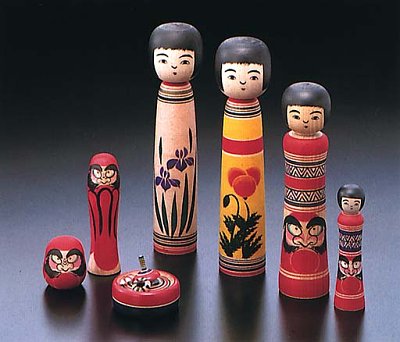
Kokeshi dolls are famous in the Tohoku region where they are still made to a large degree. These brightly-painted dolls are popular with tourists leaving the hot springs, and most Japanese girls have at least one in their collection. They first appeared in the middle of the Edo period, and there are many theories on where they came from. Some say they are derived from the toys children played with. Another story says that the wood craftsmen searching for good wood to lathe settled in the region came up with the dolls as souvenirs. Whatever their origins are, these dolls are beautiful in their simplicity. Kokeshi dolls are almost always female, though male ones are now becoming more common.
The traditional kokeshi called dento are dolls with long, slim bodies without limbs, and thicker, rounded heads. The hair, face and clothes are drawn on with simple lines and the length of the body is decorated with floral patterns or bands of bright colors. Because they are made by hand, no two dolls are alike. Some dolls are whimsical and smiling, while others are serious and contemplative. These kokeshi may come in different sizes, designs or proportions, all of which depends on the style predominant in the area it came from. There are currently eleven different styles of dento kokeshi. Shingata, or creative kokeshi, is a more modern doll style that allows the artist freedom to shape the doll as he wishes. These dolls are also limbless, but they are also more shapely, cute and animated. They look like happy children eager to go to the festival. Because they come in so many different looks, it’s easy to see why some people go crazy collecting them.
[tags]kokeshi, dolls, japan[/tags]